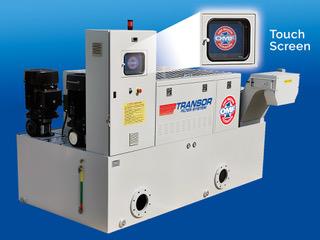
Transor Filter will debut a number of improvements to their line of One Micron Filtration systems, including a new, improved design for their V-Series Filtration units that will be in booth 237440 at IMTS 2022.
According to Irv Kaage, Transor CEO, “We continue to innovate as a company. Because Transor’s One Micron Filtration (OMF) delivers benefits to varied applications such as tool and cutter grinding, both carbide and HHS, lapping, EDM, carbide tipped saw blades and the like, we’re constantly reviewing how to improve those end user experiences.”
The addition of touchscreen technology to the unit’s control boxes will enhance communication with the machine operators. With a simple “touch”, operators will be able to display many of the machine functions in real time.
With the increase of automated and unattended machining, Transor’s new automated sludge handling device replaces the traditional sludge box. This completely automated dragout system makes the capture and reclamation of valuable materials such as carbide easy and profitable.
For heavy stock removal applications such as HSS, the new Transor SR eliminates the need for a magnetic pre-filter. The unique design of the SR provides significantly enhanced backflushing of the elements and is offered for a single machine or as a centralized system.
Contact Details
Related Glossary Terms
- electrical-discharge machining ( EDM)
electrical-discharge machining ( EDM)
Process that vaporizes conductive materials by controlled application of pulsed electrical current that flows between a workpiece and electrode (tool) in a dielectric fluid. Permits machining shapes to tight accuracies without the internal stresses conventional machining often generates. Useful in diemaking.
- grinding
grinding
Machining operation in which material is removed from the workpiece by a powered abrasive wheel, stone, belt, paste, sheet, compound, slurry, etc. Takes various forms: surface grinding (creates flat and/or squared surfaces); cylindrical grinding (for external cylindrical and tapered shapes, fillets, undercuts, etc.); centerless grinding; chamfering; thread and form grinding; tool and cutter grinding; offhand grinding; lapping and polishing (grinding with extremely fine grits to create ultrasmooth surfaces); honing; and disc grinding.
- high-speed steels ( HSS)
high-speed steels ( HSS)
Available in two major types: tungsten high-speed steels (designated by letter T having tungsten as the principal alloying element) and molybdenum high-speed steels (designated by letter M having molybdenum as the principal alloying element). The type T high-speed steels containing cobalt have higher wear resistance and greater red (hot) hardness, withstanding cutting temperature up to 1,100º F (590º C). The type T steels are used to fabricate metalcutting tools (milling cutters, drills, reamers and taps), woodworking tools, various types of punches and dies, ball and roller bearings. The type M steels are used for cutting tools and various types of dies.
- lapping
lapping
Finishing operation in which a loose, fine-grain abrasive in a liquid medium abrades material. Extremely accurate process that corrects minor shape imperfections, refines surface finishes and produces a close fit between mating surfaces.
- micron
micron
Measure of length that is equal to one-millionth of a meter.
- sawing machine ( saw)
sawing machine ( saw)
Machine designed to use a serrated-tooth blade to cut metal or other material. Comes in a wide variety of styles but takes one of four basic forms: hacksaw (a simple, rugged machine that uses a reciprocating motion to part metal or other material); cold or circular saw (powers a circular blade that cuts structural materials); bandsaw (runs an endless band; the two basic types are cutoff and contour band machines, which cut intricate contours and shapes); and abrasive cutoff saw (similar in appearance to the cold saw, but uses an abrasive disc that rotates at high speeds rather than a blade with serrated teeth).

